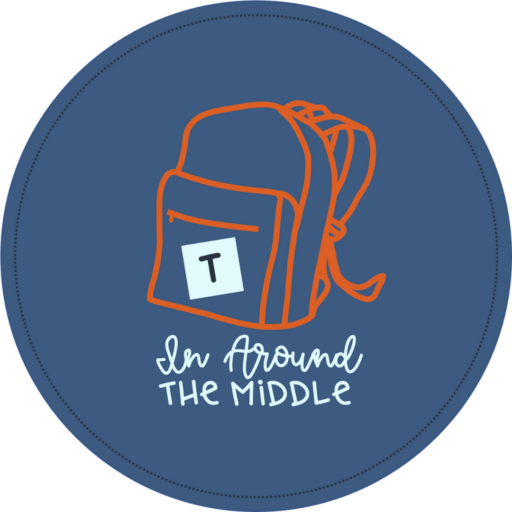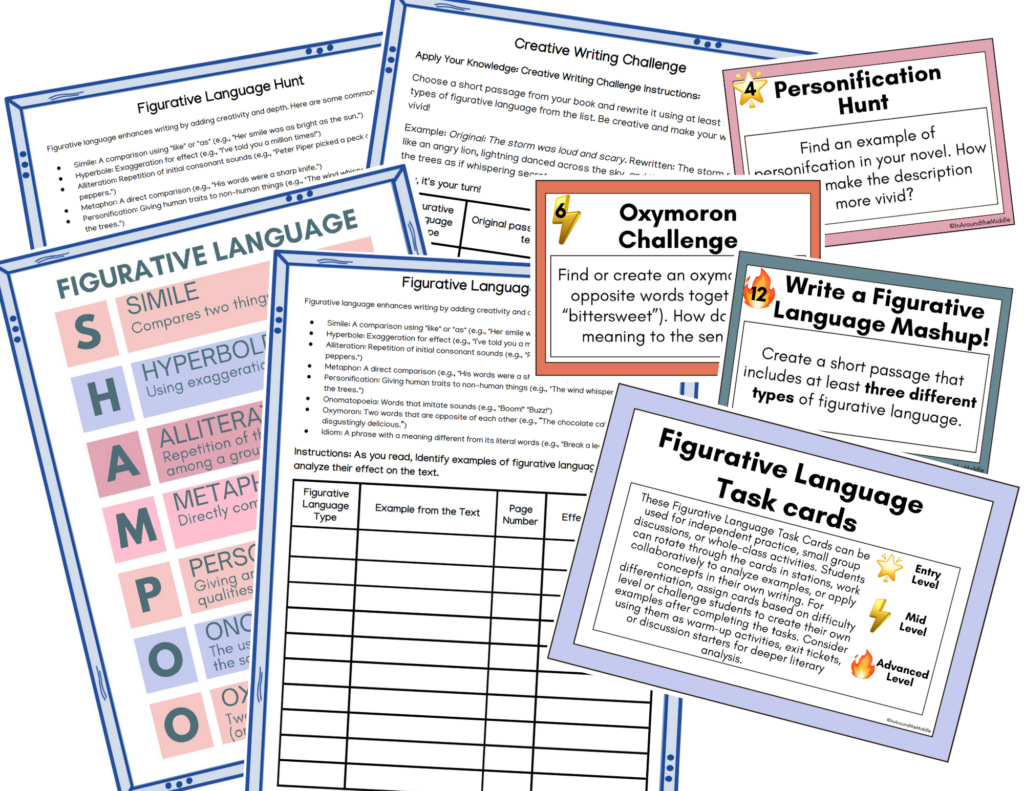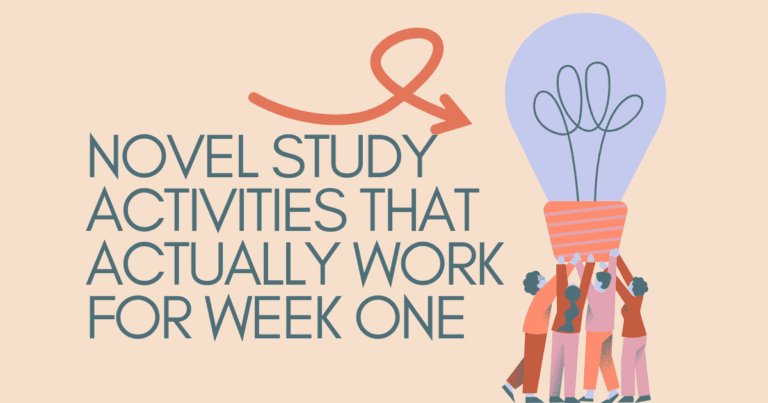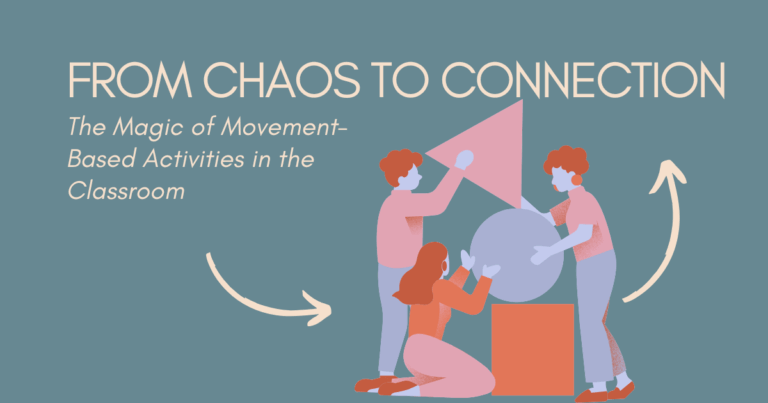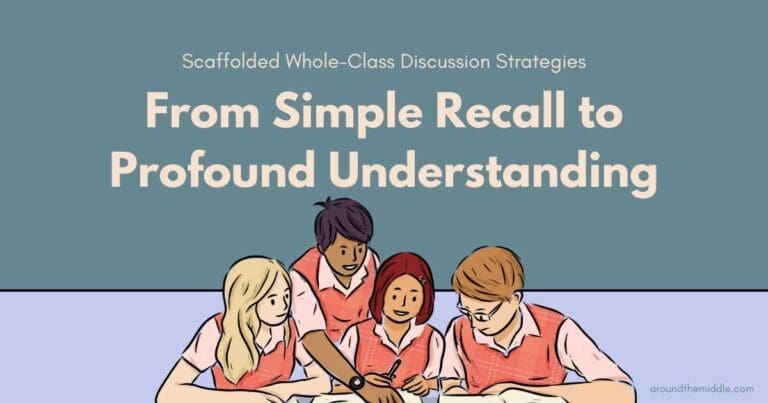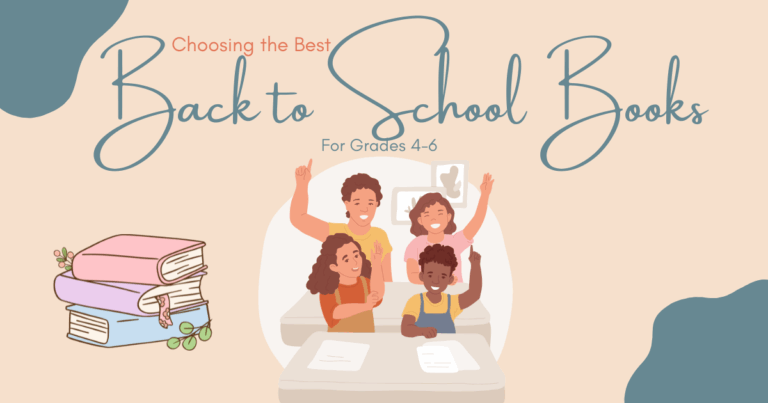The Ultimate Hack: Gamify Teaching Figurative Language
Teaching Figurative language is one of those things that can either be super fun or super boring to teach—it all depends on how you do it. In my classroom, I’ve learned that if I want my students to really get it, I need to go beyond the typical worksheet drills and actually get them engaged. And what better way to do that than by using our class novel?
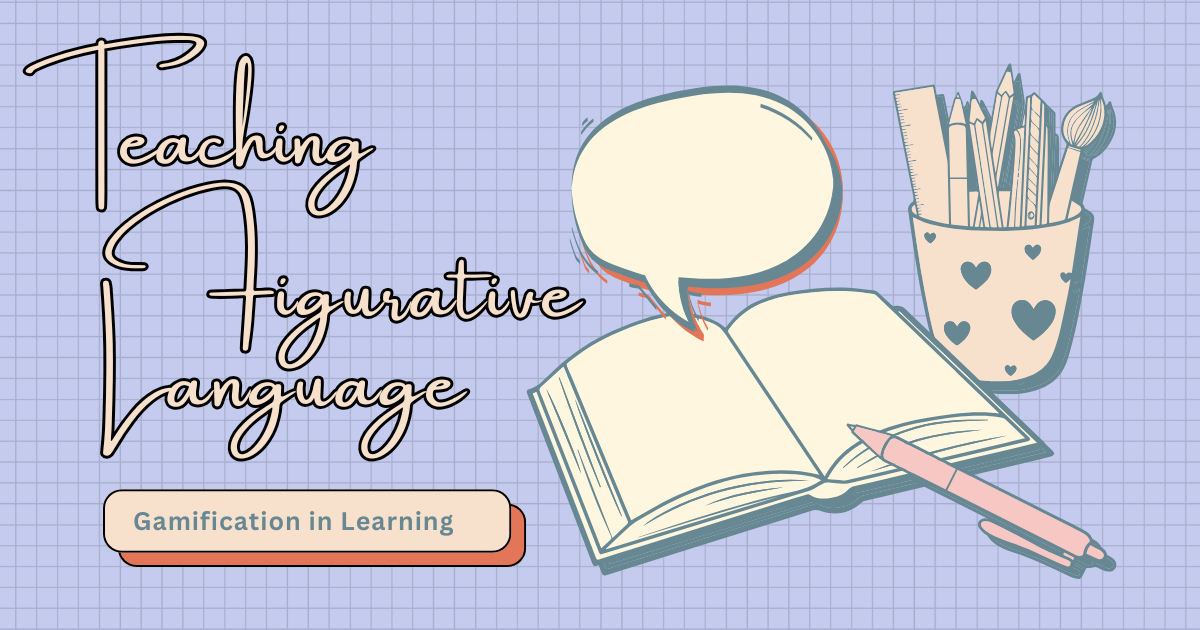
The Starting point for Teaching figurative language
getting moving
With my class this year, I knew that I was going to have to be really explicit in my teaching with lots of practice after not one, not a single one, could give me a full definition of a simile. Not just that, I know they were taught this last year; I walked through their room when it happened!
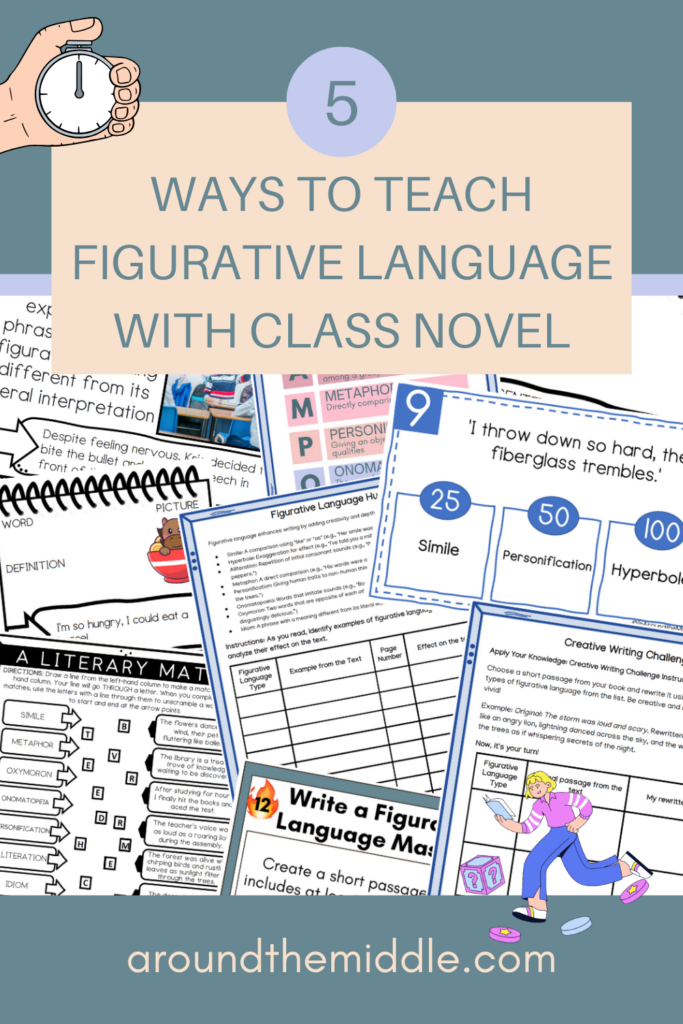
I knew, for them to remember and to actually make it stick, I would have to make it interactive, creative, and—dare I say—fun! AND, with 17 boys and 9 girls, movement was a must! So, Instead of just memorizing definitions, I had my students hunt for figurative language, move around the room, write their own examples, and even rewrite scenes from the book. I did this with a mixture of explicit teaching and gamified learning.
I’m sharing five of my favorite ways to teach figurative language using the novel you’re already reading. These are tried-and-true activities that I use in my own classroom, and they never fail to get kids thinking, laughing, and learning.
1. Word Wall Gamification
If you’ve ever put up a word wall and then totally forgotten about it (guilty!), you’re not alone. But here’s the thing—I’ve found that when I actually use my word wall instead of just letting it sit there looking pretty, it becomes one of the most powerful tools in my classroom. But to do that you need activities to go with them. Want to make it interactive and engaging, that’s where gamification of learning comes in.

My Figurative Language Interactive Word Wall isn’t just decoration—it’s a hands-on, go-to resource that my students actually use. Each literary device (simile, metaphor, personification, etc.) gets its own card with a definition, photo, and example. But instead of just reading the words, my students interact with them.
Here’s how I make it work
- Word Wall Walk 1: Students complete an activity where they walk around each example and write their the meaning in their own words, an example, and sketch their own example. For those needing a bit more differentiation I give them a sheet with some of the sections already filled in.
- Literary Match: Students connect the sentence with the matching figurative language type with a line. The line goes through a letter which they unscramble to find a code word at then end!
- Word Wall Walk 2: Students grab sticky notes and add their own examples from our class novel. It’s a living, growing resource!
- Match & Sort: I take down the examples and mix them up—students race to match them back to the correct literary device.
- Figurative Language Spotlight: Every week, we highlight one device. Students find an example in their independent reading and share it with the class.
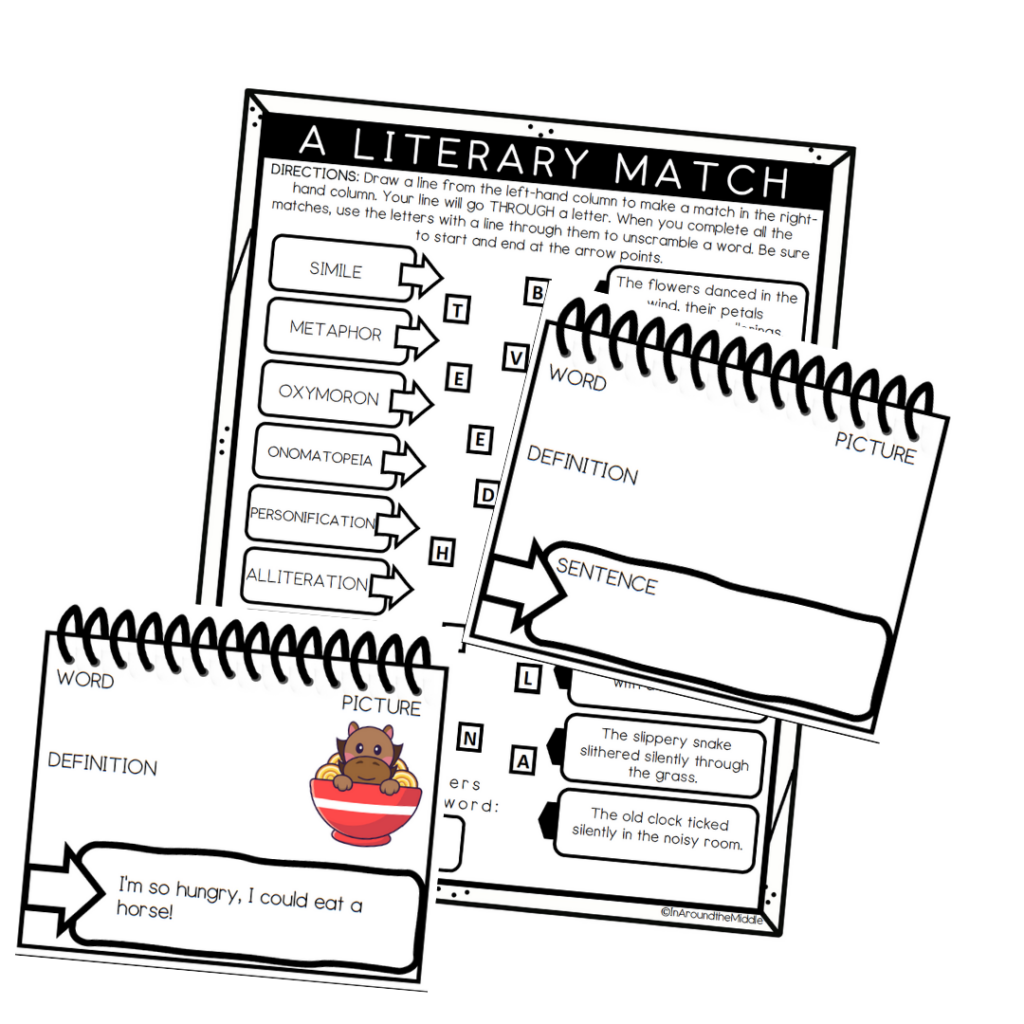
I love that this keeps figurative language visible and usable all year long. And the best part? It works with any novel we’re reading!
Want to set up your own interactive word wall? You can create your own or grab my ready-to-go Figurative Language Word Wall!
2. Figurative Language Novel Search
One of my favourite ways to get students really noticing figurative language is with a Novel Search—basically a scavenger hunt, but within the pages of the book we’re already reading. Instead of me telling them what similes and metaphors are, they find them on their own, which makes it way more meaningful!
Gamifying teaching figurative language with novels
Step 1: Start with the basics. I read the novel out loud and stop at a good example of figurative language. I repeat the sentence and asks what kind of figurative language it is. It might take a few guesses at first, but a few examples in and they really get cruising. After they’ve identified the example correctly, I ask them why they think it’s that. I do this a few times, stopping as I go, then I set the challenge.
Step 2: Choose Your Challenge Level
- The entry-level version gives students a structured table where they simply record the figurative language type, an example from the novel, and the page number.
- The advanced version takes it a step further by asking students to analyze how the figurative language enhances the text. This is perfect for pushing deeper literary discussions!
Step 3: Find the Figurative Language – Students work alone or in groups, hunting for figurative language as they read.
Step 4: Compare & Discuss – We compile our findings as a class and talk about why the author used each literary device. This is where the magic happens—students start noticing patterns, discussing author’s craft, and making connections between figurative language and the novel’s themes.
I love this activity because it works with any novel and gets students actively engaged in literary analysis! Want to try it out? You can grab my Figurative Language Novel Search Freebie and see the difference it makes in your classroom!
3. Figurative Language Scavenger Hunt
This is one of my students’ absolute favourites! Instead of a worksheet, they’re up and moving, searching for figurative language examples hidden around the room.
Gamification of the class novel
The Setup – I post novel-specific figurative language examples all over (even outside if the weather is nice!).
The Hunt – Armed with their answer sheets, students travel from station to station, identifying the literary device used in each quote. Some of them literally run to find the next one—it’s that engaging! They even stand in front of the cards and discuss and argue about the device and why!
The Challenge – Each answer has a point value, and they unlock a mystery word at the end. (A little competition never hurts!)

It turns learning into a game—and trust me, they love it! And the best part? I’ve already done the work for you! I have novel-specific scavenger hunts ready to go in my TPT store—check them out here!
4. Figurative Language Writing Challenge
This activity gets students thinking, laughing, and writing all while reinforcing figurative language. Plus, they walk away with a deeper understanding of how authors use these techniques to bring their stories to life!
Once students find figurative language, it’s time to create their own! This challenge gets them thinking like authors—and the results are hilarious.
ideas
Write Like an Author – Students pick a key event from the novel and write their own similes, metaphors, personification, idioms, and hyperboles for it. (Expect a lot of “The wind howled like a hungry wolf” and “My backpack weighed a thousand pounds.”)
Swap & Identify – They trade with a partner, who has to guess the literary device.
Class Booklet – We compile the best ones into a class reference book. Students love seeing their work in print, and it makes a great review tool!This makes figurative language fun, creative, and memorable!
5. Character Perspective Rewrite
Now we really shake things up! Students rewrite a scene from the novel using different figurative language techniques, changing the tone and imagery completely.
Choose a Scene – I pick a short passage, or they choose one themselves.
Rewrite with Style – They add similes, metaphors, and personification to transform the writing. Maybe the wind isn’t just blowing—it’s whispering secrets. Maybe the villain’s stare isn’t just scary—it’s as cold as an Arctic blizzard.
Share & Discuss – We compare versions and discuss how figurative language changes everything!
This is always a hit because students love putting their own creative spin on a story!
Bonus Tips for Extra Practice
Want to reinforce figurative language without making it feel repetitive? Task cards are the way to go! I use them for independent practice, small groups, or centers, and they keep students engaged without overwhelming them.
Other fun ways to engage with figurative language examples:
- Figurative Language Relay – In teams, students race to identify the figurative language type on each card.
- Targeted Practice – Assign specific cards based on what students need extra help with.
- Figurative Language War – Students draw a card, and the one with the most creative example wins the round!
I’ve included figurative language task cards as part of my freebie, so be sure to grab them here!
Adding the fun
Figurative language isn’t just another box to check in your lesson plans—it’s what makes stories feel real. When students actively search for it, play with it, and create their own, they start to see how authors use these techniques to bring writing to life. And let’s be honest—learning is always more fun when it’s interactive!
These five activities have been game-changers in my classroom, and I know they’ll bring figurative language to life in yours too! The best part? They can be spread throughout the year and repeated with different novels when needed!
Which of these activities are you most excited to try? Drop a comment below—I’d love to hear how you use figurative language in your classroom! And don’t forget to check out my TPT store for ready-to-go resources to make planning even easier.
Wanting more ideas on embracing gamification in the classroom? Check out my post on Gamified Lessons and Productive Struggle here.
Happy teaching!
